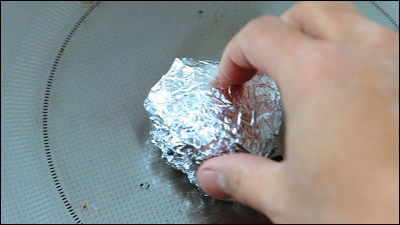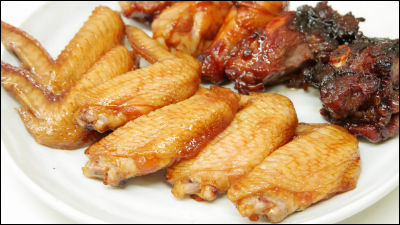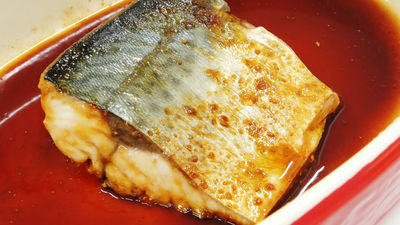A review of grilling fish and meat with the 'Yerun Plate' that can be grilled in the microwave

In principle, it is almost impossible to brown food cooked in a microwave oven, but Wahei Fraze's cooking utensil ' Yerun Plate ' is an item that overcomes the limitations of microwave ovens. It seems that. I got the real thing and tried it to find out why it can be baked in a microwave, and if it really can be 'baked'.
Wahei Freiz Co., Ltd. | Planning and sales of household goods, cooking supplies, interior goods, and household goods
So I immediately bought a burnt plate. Since it is made of ceramic, it is quite a sturdy product.
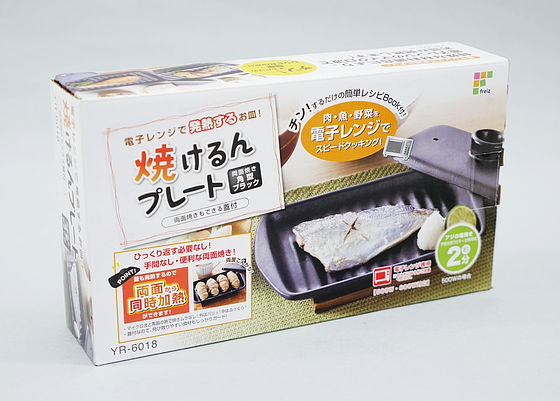
The secret to the ``burning'' of the Yakinen Plate is that not only the food but also the plate itself generates heat. In addition to the plate, the lid also generates heat, so it seems that you can heat the food by pinching it from above and below.
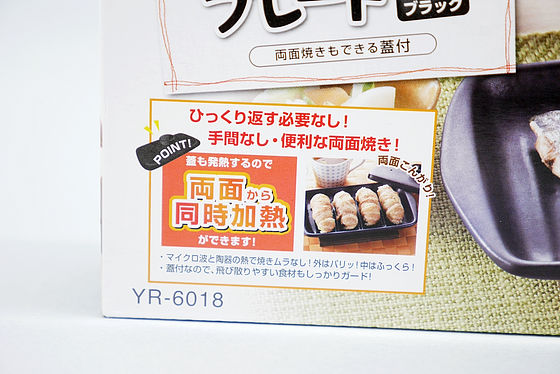
As an example, salt-grilled horse mackerel can be cooked in 2 minutes. However, you need to consider the time to preheat for 3 minutes and 30 seconds as written above.
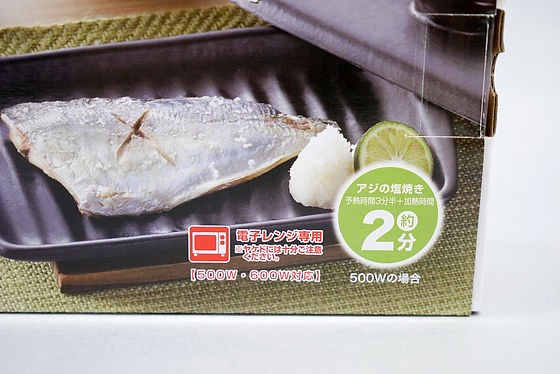
The reason why the plate itself generates heat is because the material is kneaded with ingredients that generate heat in response to microwaves from a microwave oven. I will actually try it later to see how high the temperature will rise.

The package contains a Yakerun plate, a lid, and a recipe using this product.

Set of plate and slightly small lid

A wave pattern is engraved on the surface of the plate, which allows water and oil from the ingredients to flow away.

The lid is said to be a 'drop lid' and is completely smaller in size than the plate. It seems that it is made to actively touch the food and heat it.

For example, the recipe includes salt-grilled salmon.

Also featured were standard menu items such as salt-grilled mackerel and Saikyo-yaki Spanish mackerel.

It is also possible to grill salt-grilled saury and grilled yakitori.

It seems possible to salt-grill shrimp with heads as they are.

◆I tried grilling and eating various things.
I'm going to bake a lot of things and eat them. First, I bought two pieces of salmon fillet. I'll grill one on a grill plate and the other on a fish grill on the stove to compare.

After wiping off the moisture on the surface of the fillet...

First, put it on the stove.

At the same time, put the Yakinen plate in the microwave and heat it at 500 watts for 3 minutes and 30 seconds. I'm worried that it seems to be 'empty-cooked' which should be avoided in the microwave, but it seems that it is actually made in such a way that there is no problem.

When we measure the temperature after preheating is completed

Place the remaining fillets you bought on the preheated plate...

Place the lid on top. Then, the lid and fillet will touch each other, so the lid will almost certainly be floating as shown below.

Then put it in the microwave again and heat it at the same 500 watts for 2 minutes. At this time, there is no need to turn the fillet over like you would on a stovetop.

In a short time, both the microwave and the stove finished cooking. The fillets on the white plate are grilled on the stove.

Although I was a little worried about the fillet that was ``grilled'' on the Yarunun plate, it looked like it was cooking without any problems, and the fat from the meat had fallen into the grooves. The part with a little bit of salt floating around is the same as the one baked on the stove. However, I am concerned that the edges of the fillets are a bit explosive. By the way, I heard a 'pop' sound several times while cooking.

I tried lining up the two. The fillet is cooked on the stove top and on the grill plate below.

If you compare the degree of grilling of the skin from the opposite angle, it is clear that the skin is grilled better when grilled on the stove. On the Yakerun plate, there are no grilled marks.

However, the important thing is the taste, so I'll try and compare them. First of all, when I tried the fillet grilled on the Yaken plate, I found that it was well-cooked all the way through, and it would not be an exaggeration to say that it was not only cooked properly, but that it was as good as when grilled properly on the stove. I was a little surprised by the texture. On the other hand, I could hardly feel any kind of aroma when lightly charred. The image that comes closest to it might be ``bath-bathed fillets.''

If you grill it on the stove, it has the same familiar taste. However, if you compare it with the one made with the Yakinen plate, you will notice that it still has a watery feel that makes you wonder, 'Huh?' Since the baking method should not have failed so much, it seems that the difference between the stove and the microwave appeared in the 'wateriness'.

Let's compare the degree of burnt skin. Unfortunately, you can hardly see any grill marks on the Yakirun plate. This seems to be largely affected by whether or not the lid and plate are in contact with each other. When I actually ate it, it had a ``mushy'' texture, and I could hardly feel the deliciousness I expected from ``salmon skin''.

The stove on the other hand produces the perfect amount of heat. As expected, the stove won by a landslide when it came to how well the skin was burnt.

◆I tried grilling various things other than salmon.
Following the salmon, I tried grilling salted mackerel this time. This is also cooked by preheating for 3 minutes and 30 seconds + heating for 2 minutes. Normally when you grill mackerel on the stove, the surface of the skin gets rough, but on the Yakinen plate, you can't see it at all. At first, I was so worried that it was burnt.

However, when you turn the fruit upside down, there is a surprising development. While the skin was almost unchanged, the inside was nicely grilled. If you only look at this side and compare, you will find it difficult to tell the difference.

When I ate it, it felt like it had just the right amount of heat (heat) going through it, and it was perfectly cooked. I noticed here that if you ignore the weak point of 'difficulty grilling', microwave ovens and fish don't seem to go well together.

Next was the Saikyo-yaki Spanish mackerel. Both pieces were cooked in the microwave, but perhaps because they were marinated in miso, the grill marks were just right this time.

The taste is also perfect. In fact, the wateriness had evaporated and the flavor of the meat had become easier to taste, so I started thinking, ``If you just look at the quality of the meat, isn't the microwave oven quite high quality?''

Next is a random act because I have a child. Shishamo is generally eaten crispy with fire, so I thought it would be good to use it in the microwave, so I tried it...

The result was poor. I had to be very careful about cooking shishamo in the microwave, as it lacks the aroma and crunchy texture that many people look for in shishamo, and you end up munching on squishy fish. Looks better.

Next, I tried grilled pork with ginger on the Yarunun plate using pork and ginger sauce. Although it is not mentioned in the recipe, first place just the pork on a preheated plate and heat it for a little less than 1 minute, then add an appropriate amount of sauce when the color changes. After another minute, turn the meat over and cook for another minute.

The finish is excellent. There was no fishy smell at all, and I was able to eat it as a normal ginger grill.

I tried it simply with just sausage. The skin may tear during cooking, which can happen no matter what microwave oven you use, but it's nice to see some grilled marks here and there.

I didn't feel any discomfort when I ate it. Considering the hassle of washing a frying pan, I felt that cooking on a Yakerun plate and eating it as is is a good option. However, you need to be very careful to avoid burns.

When I actually tried it, I was able to fully appreciate the benefits of cooking fish in the microwave. And while a regular plate is sufficient if you are simply cooking fish in the microwave, some people may find it worthwhile to purchase the product for the 'grilled marks' that can be expected by using the Yakinen Plate. I felt that it might be too many. When I tried it, I didn't get the impression that it was ``gritty'' when cooked over a fire, but I felt safe because of the amount of heat it received when cooking in the microwave and the fact that ``no matter who does it, there are very few mistakes such as burning.'' Even if you embrace it, you may not feel strange at all.
The regular price of the Yakinen plate is 2484 yen including tax, but it is sold for around 1000 yen at retail stores and online. There was also a case sold for 961 yen on Amazon.
Amazon.co.jp: Wahei Freiz Yerun Plate, Double-Sided Grilled Square Shape, Black YR-6018: Home & Kitchen

Related Posts:

